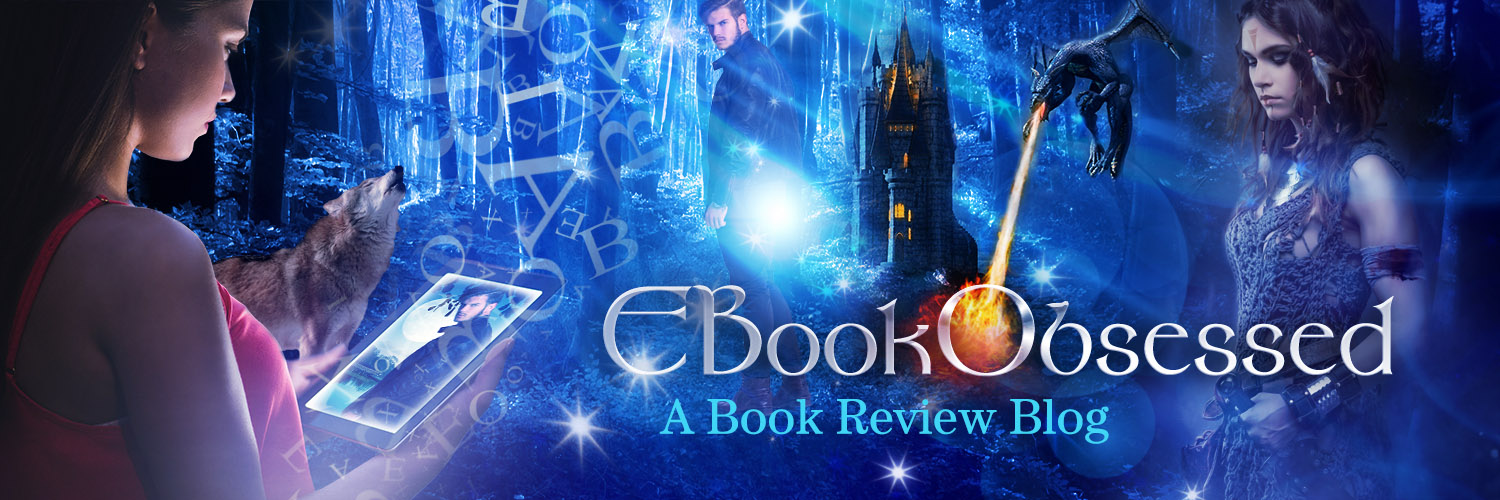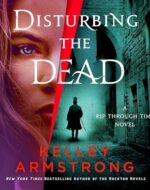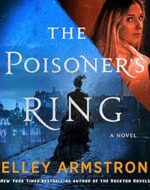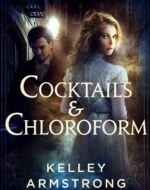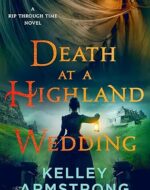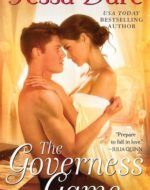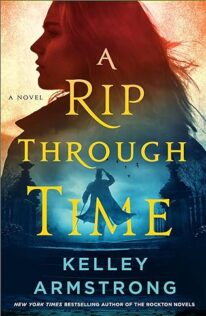 A Rip Through Time (A Rip Through Time, #1) by Kelley Armstrong
A Rip Through Time (A Rip Through Time, #1) by Kelley Armstrong 
Series: A Rip Through Time #1
Published by Macmillan Audio on May 31, 2022
Genres: Historical, Mystery
Pages: 342
Format: Audiobook
Narrator: Kate Handford
Length: 14 hrs 11 min
Source: Audible


This post contains affiliate links you can use to purchase the book. If you buy the book using that link, I will receive a small commission from the sale.
A modern-day homicide detective finds herself in Victorian Scotland—in an unfamiliar body—with a killer on the loose.
May 20, 2019: Homicide detective Mallory is in Edinburgh to be with her dying grandmother. While out on a jog one evening, Mallory hears a woman in distress. She’s drawn to an alley, where she is attacked and loses consciousness.
May 20, 1869: Housemaid Catriona Mitchell had been enjoying a half-day off, only to be discovered that night in a lane, where she’d been strangled and left for dead . . . exactly one-hundred-and-fifty years before Mallory was strangled in the same spot.
When Mallory wakes up in Catriona's body in 1869, she must put aside her shock and adjust quickly to the reality: life as a housemaid to an undertaker in Victorian Scotland. She soon discovers that her boss, Dr. Gray, also moonlights as a medical examiner and has just taken on an intriguing case, the strangulation of a young man, similar to the attack on herself. Her only hope is that catching the murderer can lead her back to her modern life . . . before it's too late.
I am obsessed with this series. I need Kelley Armstrong to stop bothering with all other writing and give me more Dr. Duncan Gray and Catriona Mitchell.
I have had this book at the top of my TBR for over a year now. In fact, I managed to pick up both a Kindle copy and an audiobook copy but it wasn’t until the recent release of Book 3, which also caught my eye, that I decided to cue up my audiobook and have spent a week going through all the books in this series. I love everything about it: the characters, the premise, the world building, the stories. I am so sad there are only three books and two short stories. I have an ARC of the October release and I am torn between starting it or holding off since once I finish it will be another year before we get back to Victorian Scotland.
The premise of the series is that 30-year-old Vancouver Detective Mallory Atkinson is visiting her dying grandmother in Edinburgh, Scotland and goes out for a jog. She hears a woman’s cries as she passes an alley and while she isn’t an officer of the law in Scotland, she does go to invest and help. What she sees is a woman in Victorian clothes being strangled and as she goes to assist, she too is strangled from behind. When Mallory wakes, she expects to be in a modern hospital only to find herself in a private house–more shocking, is to find herself looking in the mirror at the face of the young woman who she was trying to help. Mallory has somehow jumped into the body of that young woman and is now living in the year 1869, 150 years before she walked out of the house this morning.
While I enjoy reading or watching movies like Pride and Prejudice or Jane Eyre, I am reading/watching with my 21st century view of the world–which would obviously be different from someone reading an original printing of say, Jane Eyre in 1847. Obviously, that effects how I relate to the characters and the storytelling. Here we (as Mallory) take our modern thoughts and opinions into 1869 Victorian Scotland which makes Mallory a much more of a relatable character for the audience. Mallory, as the now 19-year-old Victorian housemaid, Catriona Mitchell, is definitely the fish-out-of-water trying not to stand out and trying to use her head injury as an explanation of why she is not acting herself. She speaks differently, using odd language and personally, I would have given up long before Mallory does and would have been locked away in the looney bin for declaring that I am from the future.
Mallory is trying to figure out simple Victorian things like moving with a corset on, and things like the gas lighting (I mean how many times do you still flip a switch whenever the power is out) and also how to get up to do her chores without an alarm clock. The biggest mistake she makes is pre-judging her fellow housemates based on the many Victorian novels she has read at the influence of her University Professor father.
She presumes that Dr. Duncan Gray, the owner of the house and the undertaking business will be a solemn man and his widowed sister will be a meek and proper lady only to find that Isla Balentyne is a chemist (although Victorian Scotland doesn’t allow her to be licensed) and Dr. Duncan Gray is a doctor who experiments in the infancy of forensics and helps his Detective friend, Hugh McCreadie. If Mallory has to end up back in past, working in the house of a forensic doctor who works with the police, could be very interesting.
The biggest mistake in judgment that Mallory makes is she looks at the face in the mirror and presumed that the 19-year-old, blonde-haired, blue eyed angel looking back at her was a sweet, innocent, hard-working yet poor girl only to find out that Catriona Mitchell was a thief and a liar who not only stole from her employers but who backstabbed every other thief in the old town. Now she has to convince everyone, and I mean, EVERYONE, that she is no longer that Catriona which no one really believes. She also realizes that if she is in 1869 in Catriona’s body, that thieving Catriona could be in 2019 wreaking havoc to Mallory’s life in her body and causing trouble as a thief with a badge.
I loved all the characters we are introduced to. The case where Mallory helps Duncan and Hugh solve is an interesting mystery. Mallory trying to blend into Victorian Scotland without giving herself away is entertaining. When I finished, I wanted more and I was so excited that there were more books to grab.
BUT–this is one of those stories where I am going to tell you that you really want to grab the audiobook version!!! Kate Handford does a great job, especially jumping between the voice of Mallory as herself and as Catriona, with her Scottish accent, because sometimes Mallory slip up and forgets herself and even we aren’t catching it until we get a “what did you say?” It truly added to the whole ‘would a modern day person be able to fit in going back in time without being caught?’ If you have some audible credits that you have been banking, definitely use one on A Rip Through Time, and hopefully, you have two more saved for books 2 and 3 because these stories are so much fun.
Favorite Scene:
To modern police, matching weapons to wounds is as obvious as dusting for fingerprints or gathering DNA. None of that exists in the Victorian world. Oh, I’m sure police have started matching weapons and wounds, but still, it is the early days of it, which makes Gray a pioneer in my favorite science.
This is why McCreadie snuck Evans’s body in. So Gray could get a look before the coroner started carving it up, and presumably so Gray could give his friend insights that McCreadie might use in his investigation.
With that, Duncan Gray becomes a thousand times more interesting.
“What do they call what you’re doing?” I ask. “Criminal science?”
“There’s a word used in medicine,” he says. “Forensics. It is used for scientific studies that play a role in the judicial system.” He pauses. “The judicial system meaning court, such as in a criminal trial.”
“This is forensic science, then?”
“You could call it that, though it’s hardly a recognized discipline.”
“It’s new then? The idea of what you’re doing? Matching weapons to wounds and such.”
He laughs, and the sound startles me. When I glance over, he looks very different from the man I’ve been serving for the last two days. He’s relaxed and comfortable, absorbed by his work and forgetting that his student is a mere servant. A female servant, no less. Or maybe that’s unfair, and it’s not so much forgetting as not caring. I’m interested, and that is all that seems to matter.
“No,” he says. “It isn’t new at all. I have a book on such scientific inquiry from thirteenth-century China, and it’s not even the first of its kind–only the first that survives.”
“Seriously?”
That very modern exclamation has him looking up in surprise, but his eyes only twinkle with amusement. “What shocks you more, Catriona? That the science is so old? Or that it is not the invention of the grand British Empire?”
“That it’s so old,” I say, honestly.
When I say that, his nod grants me a point for not falling into the trap of colonialist thinking. That’s when I notice his skin tone. Oh, I’d noticed it obviously. When we first met, I’d noted it was brown, which was no different from observing his height or eye color. Yet I hadn’t paused to realize that people of color might be less common here. I’m sure they’re not nearly as uncommon as Hollywood historical dramas would suggest, but we aren’t yet in the age of easy travel and immigration.
What would it be like to be a person of color in Victorian Scotland? Worse than being one in modern Vancouver, I presume, and even that’s not always easy, as I know from friends. How does the outside world treat him? How did Catriona treat him? I need to bear that in mind. If he seems cool and distant, there may be a reason. Right now, though, he’s relaxed, drawn into a topic that clearly interest him.
I continue, “If the science is that old, why don’t we already know all this? We’ve had five hundred years to figure it out.”
That smile quirks again. “Perhaps we do know it, just not in this corner of the globe. Or perhaps the need for it in this corner is relatively recent, as our judicial–court–system develops.”
“Or as the lawyers get better at their jobs, and police need to work harder to make their case.”
His laugh is sudden and sharp. “True enough.”
I flip through the notebook. “So this is for police work. Observations on weapon marks.”
“Among other things. Now, if you could please make note of the damage under his fingernails.”
I lean forward to peer at dark bruises where the nails have separated from the beds. I wince. “He was tortured.”
“Tortured?”
At his tone, I pull back. “I mean, it is possible someone did that to him, perhaps as a method of extracting information, by putting something under his nails. It would be very painful. I believe I have heard something like that. Somewhere.”
“I am aware of your background, Catriona. My sister told me the full story. I understand that you may, in your felonious circles, have encountered such a thing, so there is no need to dissemble.”
Felonious circles? Well, well, you do have an interesting past, Catriona.
I nod, gaze lowered. “Yes, sir. Well, then, may I speculate that this poor lad was tortured?”
“You may, particularly as that would explain this.” He pries open the victim’s mouth to show a missing tooth, the gum still raw. “The doctor performing the autopsy speculated that it had been knocked out in a blow, but I see no evidence of a head injury. Extraction seems most likely. I have heard of that being used to torture, during times of war, but did not make the connection. Thank you, Catriona. Now if the tooth was extracted, some tool must have been used. Let us take a closer look at the gums for signs of that.”
And so he continues, quite merrily examining the victim and theorizing on how the tooth may have been removed. I take notes, make appropriate noises, and send up yet more apologizes to poor Catriona, who is about to return and discover that not only is she expected to be able to read and write, but to listen to her employer speculate on methods of torture without batting an eye.
“You shall need to convey all this to Detective McCreadie,” I say when he finishes examining the mouth and hands. “It is vital information in solving the crime.”
“Is it? I’m not certain about that, Catriona. We do not know what was used to torture the poor lad, and so this cannot help Detective McCreadie.”
“It helps because it proves this isn’t a random victim,” I say. “His killer wanted information from him.”
Gray frowns at me. “What’s that?”
I hesitate. Then I plow forward. In for a penny, in for a pound. “There are two reasons to torture a person. One is sadism–the torturer enjoys inflicting pain. Two is the, well, practical purpose. Extracting information. This particular type of torture suggests the latter. The killer only damages three fingernails and took one tooth. I probably shouldn’t say ‘only’–they are still terrible things to do–but the point is that he did not do more, which would argue against sadism as the motive.”
And now Gray is openly gaping at me.
“It makes sense, doesn’t it?”
“It…does. What was that term you used? Sad…ism? Related to the Marquis de Sade, I presume?”
I shrug. “Never heard of him. The point is simply that this is torture for the purpose of extracting information rather than extracting pleasure, either for the torturer or–” I cough. “The point is that this is not a random murder.”
“In which case, the staging could be more significant than I presumed. I thought it was simply for shock. To garner attention.”
“Could be,” I say. “Probably is. What Detective McCreadie needs to know is that the victim had something his killer wanted. That’s significant.”
“It is. Excellent work, Catriona. Now–” A clock rings the hour, and he curses under his breath.
“If you need a little more of my time, sir, I can spare it.”
“Unfortunately, no. There is someplace I need to be. The police are addressing the media regarding this.”
“A press conference?”
He doesn’t miss a beat at the modern phrase, just waves his hand dismissively. “Some newfangled idea from the commissioner. Personally, I fear it does more harm than good, but sadly, the police are not subject to the Hippocratic oath.”
I snort a laugh at that, which has him turning, brows knitting, only for him to remember what he’s doing, putting away his tools.
